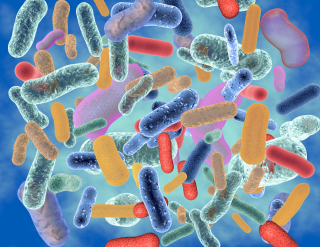Microbiome
Summary

The Earth is home to an estimated 5•1030 unicellular microorganisms accounting for nearly half of the Earth’s biomass. Microbes have essential roles in regulating global biogeochemical processes that directly impact the atmosphere, environment and all biological processes. Their enormous capacity for genetic diversity has led them to adapt to nearly every environmental niche on Earth, including colonizing humans.
The NIST Microbiome Program supports the rapidly growing industries that are developing microbial-based solutions to treat disease, improve human and environmental health, enhance agricultural productivity and food safety, bioremediate waste, produce new biofuels, and avert infrastructure corrosion. Our efforts include 1) developing measurement assurance strategies and innovative measurement solutions, 2) convening stakeholders, including regulatory agencies, to identify industry-wide challenges and pre-competitive solutions, and 3) leading and contributing to the development of reference materials and documentary standards. Together, we aim to accelerate research and development to commercialization through biometrology, data, and globally harmonized practices and standards.
DESCRIPTION
Microbiomes are complex communities of microorganisms that form resilient ecological networks that profoundly affect their host environment. Research has connected these complex microbial systems to beneficial and problematic outcomes with respect to human health and disease, agricultural productivity, water and food safety, waste remediation, and infrastructure corrosion.
Biopharma companies are currently developing the next new modality of drugs: live bacteria. These “bugs-as-drugs” (categorized as “Live Biotherapeutic Products” (LBPs) by the FDA) are demonstrating promising clinical efficacy and could change the paradigm for treating a wide range of diseases and health conditions. The quality of these manufactured LBPs must meet extremely high-quality standards as per FDA regulation. New, validated analytical methods for demonstrating the identity, purity, potency and stability must be established.
Engineering Standardized Microbial Ecosystems
NIST scientists and engineers are developing fabricated, standardized microbial ecosystems, in vitro, to measure functional traits and emergent activities related to interspecies interactions. These model microbial communities can be reproducibly engineered, measured, and modeled. NIST is home to the necessary cross-disciplinary expertise in microfluidic engineering, microenvironment nanofabrication, multidimensional bioprinting, advanced imaging, microbiology, 'omics measurements, analytical chemistry, and mathematical modeling required to design, build, and characterize reproducible microbial communities.
Workshops on Standards for Microbiome Measurements
NIST hosted stakeholders from other federal agencies, academia, and industry at two workshops that focused on Standards for Microbiome Measurements. These workshops are intended to support research investigations and commercial translation of microbiome science by identifying the necessary measurement assurance tools. Video/audio recordings are available on the workshop websites. Please check the NIST microbiome homepage for future workshop announcements.
The Fast Track Action Committee on Mapping the Microbiome
In February 2015, representatives from 14 government organizations, including NIST, established The Fast Track Action Committee on Mapping the Microbiome (FTAC-MM) by action of the Life Sciences Subcommittee (LSSC) of the National Science and Technology Council (NSTC) Committee on Science (CoS). The FTAC-MM released a report in November 2015 and also published An Assessment of US Microbiome Research in January 2016. These reports identify areas of current Federal investment, research needs, and resource gaps for the development of an integrated Federal plan for microbiome research and identified priorities necessary to achieve a predictive understanding of microbiomes and their functions. The need for standards and reference materials was identified as a priority area for Federal agency coordination and cooperation.
The Microbiome Interagency Working Group
Chartered in February 2016, the Microbiome Interagency Working Group (MIWG) includes 23 U.S. government agencies, including NIST, and serves as part of the internal deliberative process of the NSTC to provide overall guidance and direction for microbiome research across the Federal government agencies. In April 2018 the MIWG released a five year Federal Interagency Strategic Plan for Microbiome Research that provides recommendations for improving coordination of microbiome research among Federal agencies and between agencies and non-Federal domestic and international microbiome research efforts.
Metagenomic Measurements
Metagenomics, or identifying the organisms present in a sample through DNA-based analysis, is a revolutionary technology made possible through advances in sequencing technologies and computing power. Like all analytical methods, standards are needed to benchmark performance and enable translation into applications such as clinical diagnostics, microbiome therapeutics, environmental monitoring, and biosurveillance. Given the complexities of the analyses, an entire suite of NIST Reference Materials are under development to provide measurement assurance.
Fecal Metabolomic Measurements
Functional microbiome measurements are necessary to identify the molecular mechanism(s) that are responsible for the observed clinical efficacy of Fecal Microbiome Transplants (FMTs) and other Live Biotherapeutic Products (LBPs). Mass Spectrometry and NMR-based metabolomic measurements of the gut microbiome are emerging as valuable tools for measuring the complex biochemical signaling that occurs within the gut microbiome. At NIST, we are developing a human gut microbiome metabolomic reference material that allow researchers and to standardize their metabolomic measurements.
Human Gut Microbiome Reference Material
To identify new biomarkers that may serve as disease indicators and to understand biologically relevant properties of the human gut microbiome, we need validated analytical measurements that accurately describe various properties of these complex microbial ecosystems, both quantitatively and qualitatively. The most common measurements currently being used to describe these complex microbial communities are 1) NGS-based metagenomics and 2) mass spectrometry-based metabolomics. In either case, no fit-for-purpose standards exist that enable researchers to compare results generated across different laboratories and to assess the impact of the multitude of methodological variables that exist in either measurement platform. Here we propose to develop a candidate Human Gut Microbiome (Whole Stool) Reference Material that is demonstrated to be homogeneous and stable with respect to the microbial taxa (DNA) and key metabolites. This same material will ultimately be value assigned for both the identification and mass fraction content (as appropriate) for a panel of clinically-relevant metabolites and/or nutritional assessment metabolic markers.
Contacts
Leader, Complex Microbial Systems Group
-
(301) 975-5460

